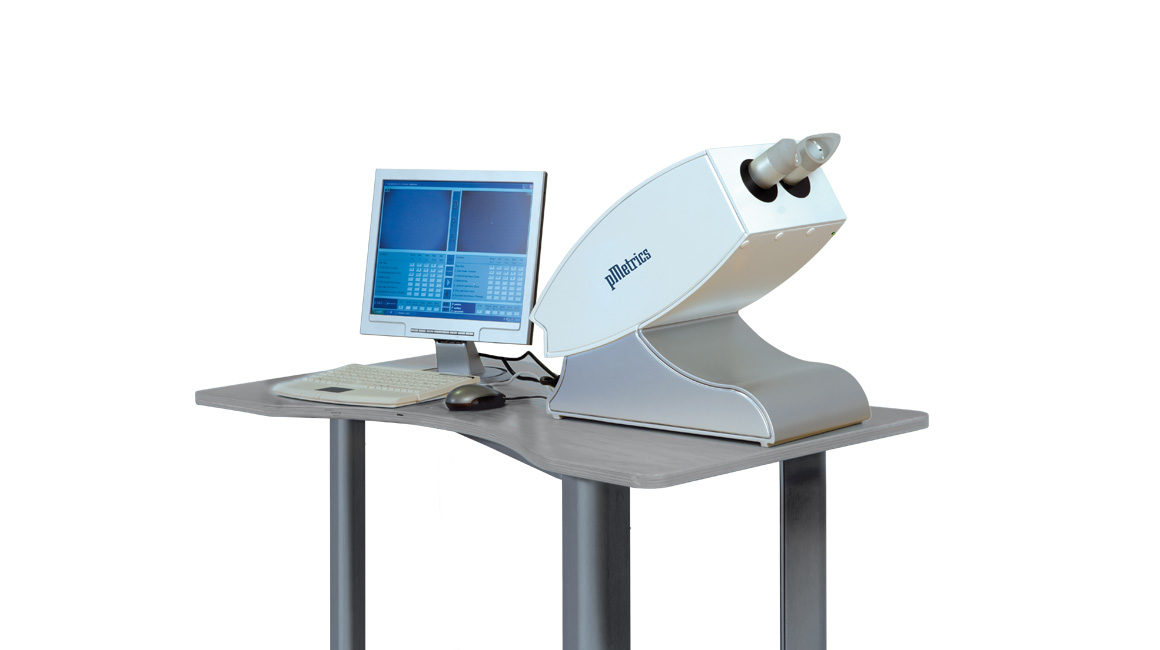pMetrics® – Dynamic Pupil Assessment
Pupil dynamics applied to customized corneal surgery.
Designed in-house and fully integrated into the iVis Suite™, pMetrics®, by means of the patented Ideal Pupil determination, allows the customization of the optical zone for refractive surgery purposes, to minimize surgical invasiveness.
pMetrics® assess six (6) different lighting environments in order to simulate a full range of scotopic to photopic variable environments and thus, accurately pinpoint pupil dynamics. The recorded data are matched with patient’s lifestyle in order to determine the Ideal Pupil which encompasses 95% of all pupil conditions of the patient during awake hours.
pMetrics® accurately defines the real optical zone of the ablation to be treated, based upon the Ideal Pupil computation while taking into account the anterior chamber depth, and thus minimizing the invasiveness of the treatment.
pMetrics® also allows the determination of the customized near vision inner refractive zone for multifocal refractive treatments and to support the customized selection of multifocal IOLs.
pMetrics® provides a detailed pupil response graph and a lifestyle weighted statistical analysis determining the Ideal Pupil dimension.
– Automated statistical and life style weighted analysis in 6 different light conditions
– Dynamic measurements in controlled environments from scotopic to photopic condition
– Telecentric optics with constant magnification in focal depth
– Visual environments real-time control
– Custom patient’s lifestyle
– Standardized illumination environments
– Minimum, maximum and mean pupil dimensions per environment
– Dynamic pupil analysis and lifestyle-related reporting
– Pupil dynamic assessment
– Ideal Pupil definition for Refractive and Therapeutic corneal surgery
– Multi-focal IOL selection
– Central zone optical definition for multifocal treatments
– Determination of the photopic and scotopic pupil
– Frame rate: 25 Hz
– Accuracy: ≤ 35 micron
– Visible light illumination: Diffuse and direct light intensity automated control
– Acquisition time: Average time 2.5 minutes depending from patient’s accommodation time
– Acquisition type: binocular or monocular
Ideal Pupil

Contemporary refractive and cataract surgeries require complete analysis of the patient’s pupil dynamics. To estimate pupil dimensions or to assume that pupils are “normal” sized, applying standard-size ablation dimensions results in either too small optical zone with lasting halos or starbursts, or conversely the unnecessary corneal tissue removal.
pMetrics® applies strong science to eliminate the one-size-fits-all ablation dimension approach in refractive surgery.
pMetrics® tests dynamically the binocular pupil responses to 6 calibrated light conditions ranging from scotopic to photopic and includes diffuse lighting and glare sources. This analysis allows Surgeons to raise the standard of care by measuring binocular pupil dimensions and reactivity dynamically in a full range of visual environments.
The Ideal Pupil size is then calculated by matching the individual pupil’s dynamic responses to specific visual environments, lighting conditions, lifestyle weighting. pMetrics® uses a proprietary statistical analysis system and the result is statistically significant to 95% of the patient’s typical day-to-day visual experiences.
pMetrics® defines the optical zone of the refractive treatment by means of the projection of the Ideal Pupil onto the anterior surface of the cornea surface. The measurement is critical to deliver optimum coverage to assure that the patients do not experience undesired outcomes due to a too small optical zone, and do not have excessive tissue removed due to “standard size” optical zone.
The Ideal Pupil grants to the Surgeon the capability to define the objective ideal optical zone for refractive and therapeutic treatments, for the choice of the multifocal IOLs and for the definition of the width of the central area of the cornea to be dedicated to near vision in multifocal surgery.
The pMetrics® patented technology significantly enhanced the standard of care delivering properly dimensioned refractive surgery.




